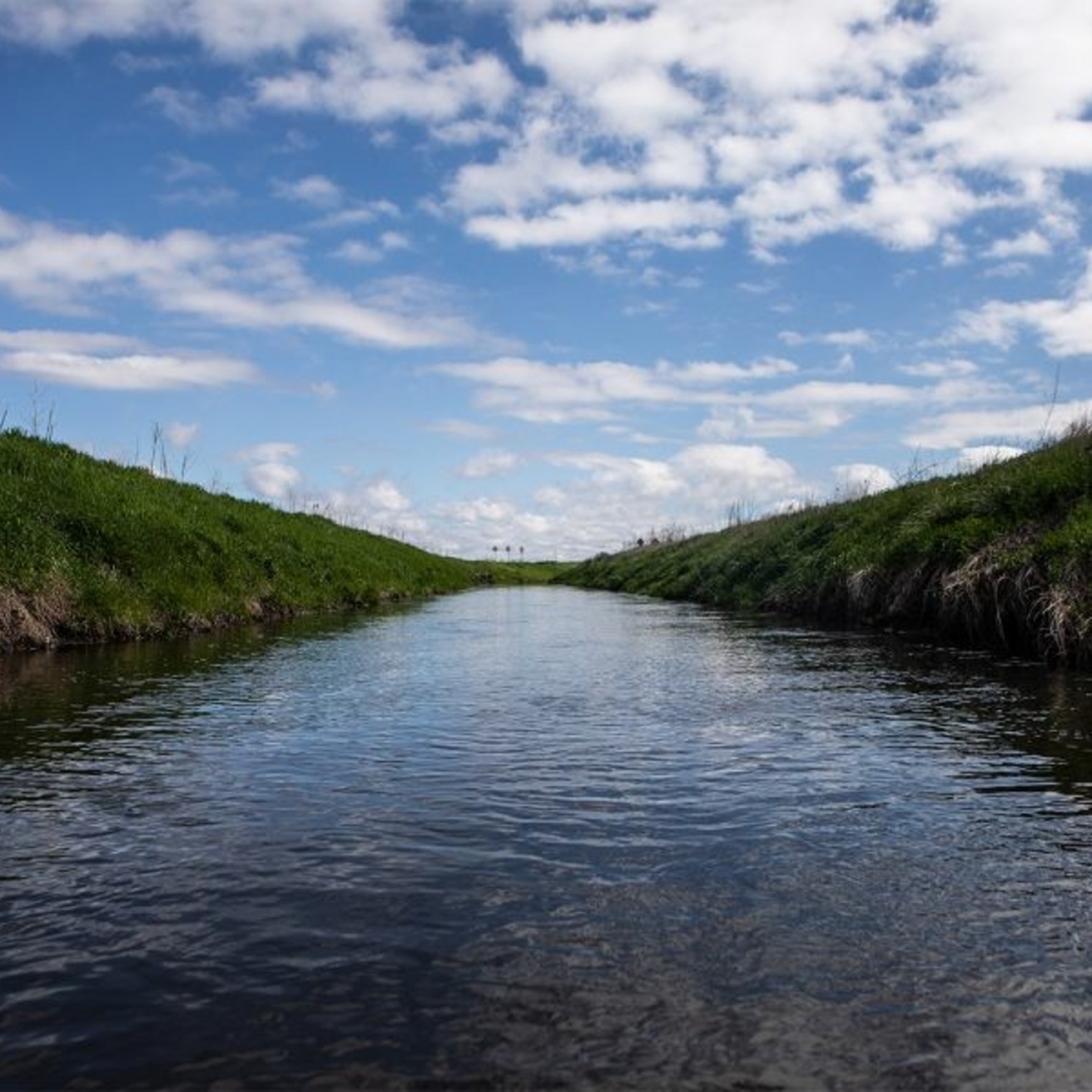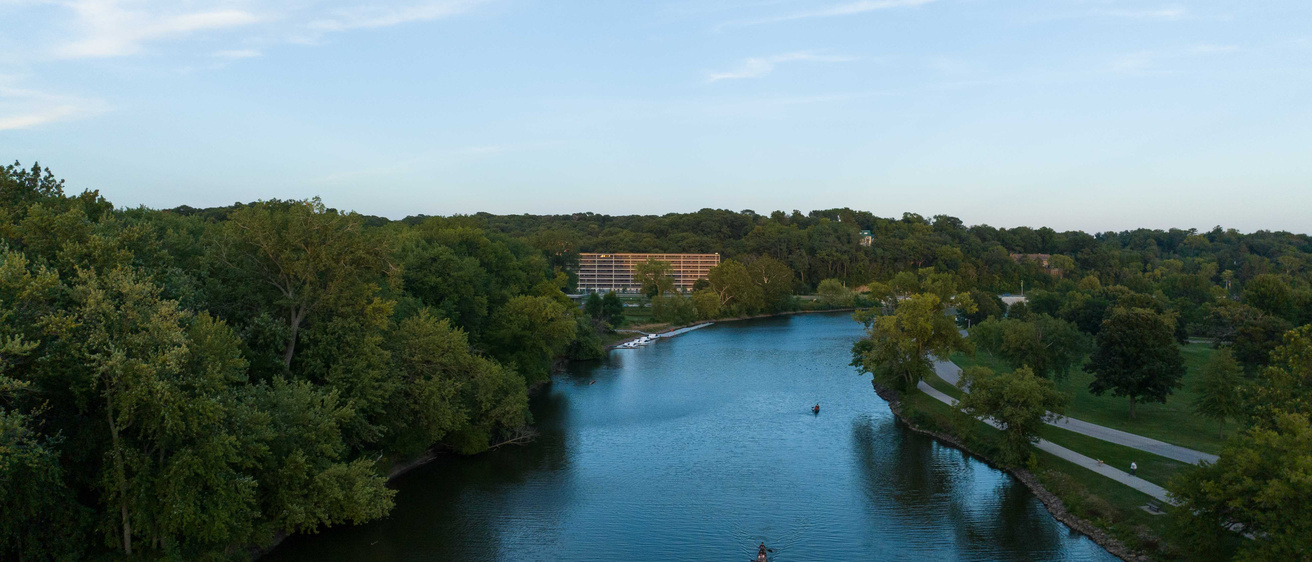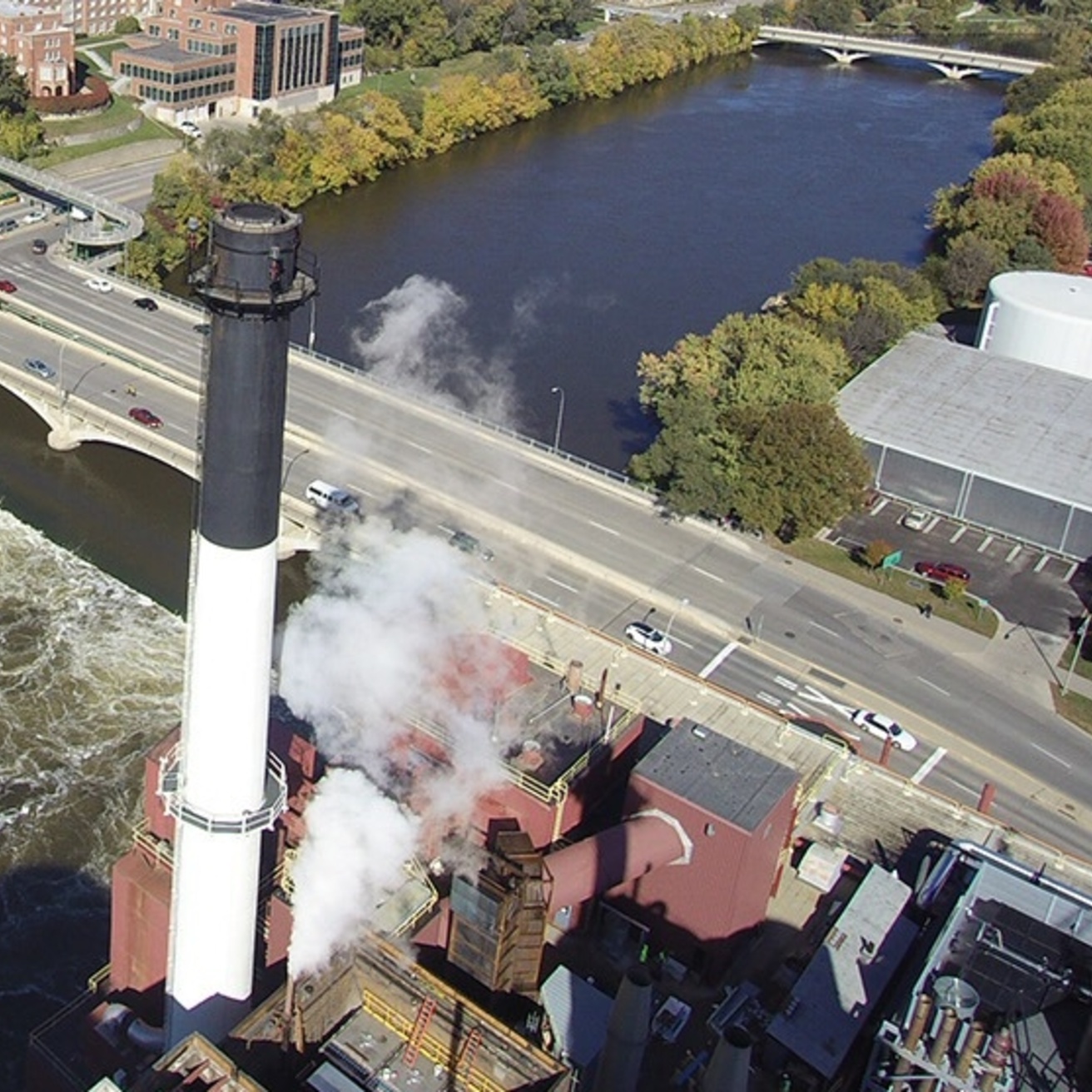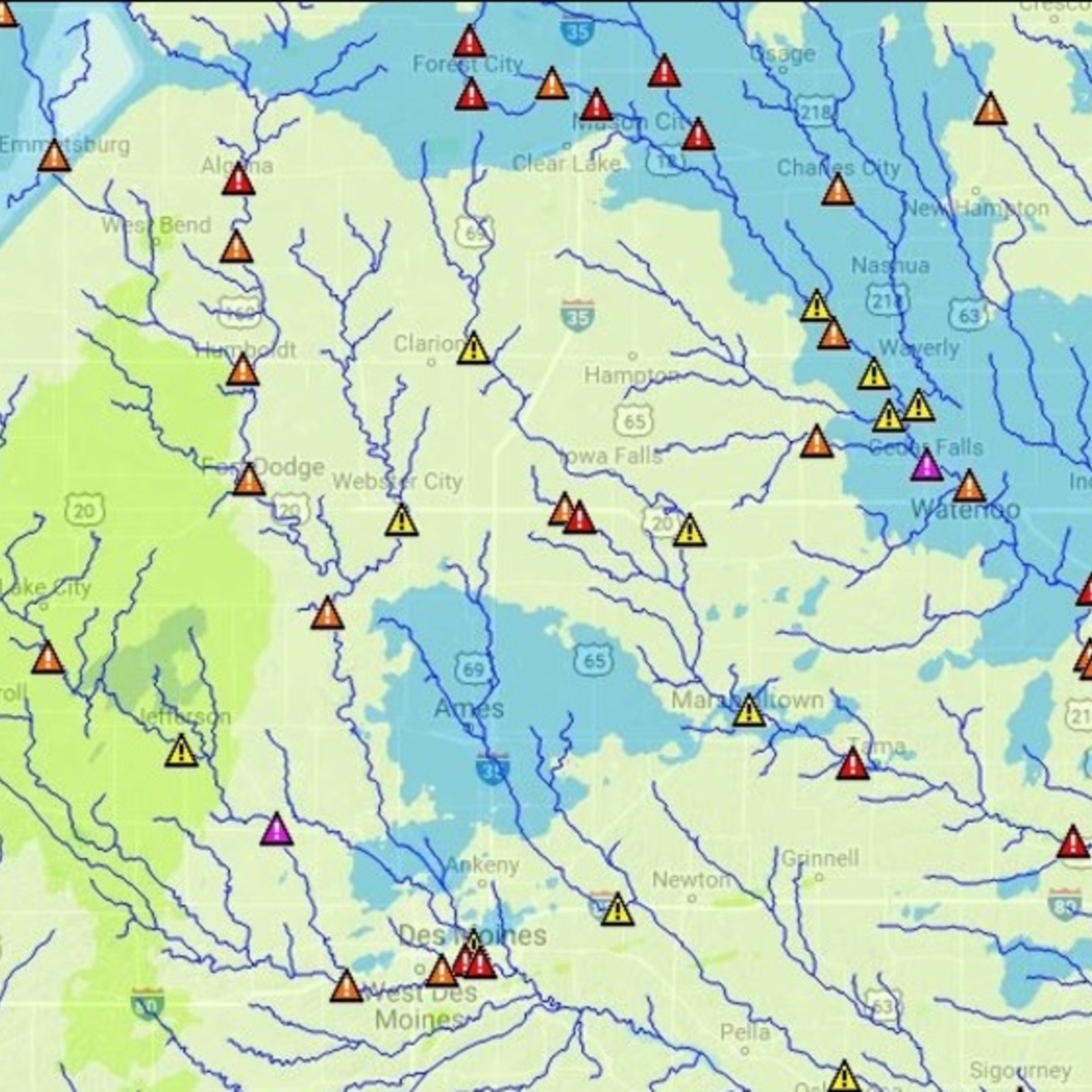Improving our Water Quality
After the University of Iowa successfully achieved Goal #6 of the 2020 Sustainability Goals by supporting and growing “interdisciplinary research in sustainability-focused and related areas,” we set our sights on furthering the reach of sustainable practices by emphasizing specific areas for improvement. Through the Shared Governance process, the University of Iowa has worked with campus partners to produce sustainability goals within The UI 2022-2027 Strategic Plan. One of these goals is to “improve water quality in the Iowa River by creating best practices for stormwater management and water conservation.” Below are the University’s efforts and progressions towards developing a more sustainable community by protecting, managing, and studying our water.
IIHR—Hydroscience & Engineering
"IIHR—Hydroscience & Engineering is a world-renowned center for education, research, and public service focusing on fluids. Based in the C. Maxwell Stanley Hydraulics Laboratory, a five-story red brick building on the banks of the Iowa River, IIHR is a unit of the University of Iowa’s College of Engineering. At IIHR, students, faculty members, and research engineers work together to understand and manage one of the world’s greatest resources: water. Students from around the world benefit from IIHR’s comprehensive multidisciplinary approach, which includes laboratory experimentation, computational approaches, and observational field research."
Iowa Flood Center
"The Iowa Flood Center is part of the University of Iowa College of Engineering and is the nation's only academic research center devoted solely to flooding. The IFC develops innovative tools and reliable information that decision-makers, emergency responders, community leaders, home and business owners, educators, and the public depend on to help them understand and reduce their flood risks and make better flood-related decisions. The center's work is accessible to everyone through the online Iowa Flood Information System which communicates real-time information about stream levels, flood alerts and forecasts, and hydrologic conditions for the entire state."
Stormwater Management
What is Stormwater Runoff?
Stormwater runoff is water from rain or snow melt that runs off solid surfaces such as roads, buildings, and compacted soils. This water is collected and transported through storm sewer systems before being deposited into streams, rivers, and lakes without being treated. Stormwater runoff can be easily polluted as it may pick up substances such as pesticides, fertilizers, and oils that can harm the water in any quantity. Other, more natural pollutants, like bare soil, pet waste, leaves, and grass clippings, can still be harmful to creeks, rivers, and lakes. According to Facilities Management, "polluted runoff generally happens anywhere people use or alter the land," and "runoff not only pollutes but also erodes stream banks."
How is Stormwater Runoff Managed?
"'Best management practices' is a term used to describe different ways to keep pollutants out of runoff and to slow down high volumes of runoff. Preventing pollution from entering water is much more affordable than cleaning polluted water. Educating state residents about how to prevent pollution from entering waterways is one best management practice. Laws that require people and businesses involved in earth disturbing activities--like construction and agriculture--to take steps to prevent erosion are another way to prevent stormwater pollution. There are also laws about litter, cleaning up after pets and dumping oil or other substances into storm drains. Education and laws are just two best management practice examples. Some BMPs are constructed to protect a certain area. Some are designed to slow down stormwater, others help reduce the pollutants already in it–there are also BMPs that do both of these things. Detention ponds, built to temporarily hold water so it seeps away slowly, fill up quickly after a rainstorm and allow solids like sediment and litter to settle at the pond bottom. Then, they release the water slowly. These ponds are one constructed BMP example. Green roofs, storm drain grates, vegetated filter strips, and permeable paving are other examples.
The University of Iowa's stormwater permit covers all 1,968 acres of the campus. To monitor the quality of water discharged into waterways, sampling of water discharge, tracking of water flow, and annual inspections of all outfalls into waterways will be done" (Facilities Management).
Why is it Necessary to Manage Stormwater Runoff?
"Polluted water creates numerous costs to the public and to wildlife. As the saying goes, “we all live downstream.” Communities that use surface water for their drinking supply must pay much more to clean up polluted water than clean water. Polluted water hurts the wildlife in creeks, streams, rivers and lakes. Dirt from erosion, also called sediment, covers up fish habitats and fertilizers can cause too much algae to grow, which also hurts wildlife by using up the oxygen they need to survive. Soaps hurt fish gills and fish skin, and other chemicals damage plants and animals when they enter the water. The quantity of stormwater is also a problem. When stormwater falls on impervious surfaces like roads, roofs, driveways and parking lots, it cannot seep into the ground, so it runs off to lower areas. To give you an idea of the difference an impervious surface makes, consider the difference between one inch of rain falling onto a meadow and a parking lot. The parking lot sheds 16 times the amount of water that a meadow does! Because more water runs off impervious surfaces, developed areas can experience local flooding. The high volume of water also causes streams banks to erode and washes away wildlife habitat downstream" (Facilities Management).
How Can I Reduce Pollution in Stormwater Runoff?
"If you own a car, maintain it so it does not leak oil or other fluids. Be sure to wash it on the grass or at a car wash so the dirt and soap do not flow down the driveway and into the nearest storm drain. If you own a yard, do not over fertilize your grass. Never apply fertilizers or pesticides before a heavy rain. If fertilizer falls onto driveways or sidewalks, sweep it up instead of hosing it away. Mulch leaves and grass clippings and place leaves in the yard at the curb, not in the street. Doing this keeps leaves out of the gutter, where they can wash into the nearest storm drain. Turn your gutter downspouts away from hard surfaces, seed bare spots in your yard to avoid erosion and consider building a rain garden in low-lying areas of your lawn. If you have a septic system, maintain it properly by having it pumped every three to five years. If it is an older system, be sure it can still handle the volume placed on it today. Never put chemicals down septic systems, they can harm the system and seep into the groundwater. Pet owners should pick up after their pets and dispose of pet waste in the garbage. Keep lawn and household chemicals tightly sealed and in a place where rain cannot reach them. Dispose of old or unwanted chemicals at household hazardous waste collections sites or events. Never put anything in a storm drain. Don’t litter. Participate in the next stream cleanup in your area. Storm drain stenciling events (where the destination of stormwater is clearly marked on a drain) are a fun way to let your neighbors know the storm drain is only for rain. Attend public hearings or meetings on the topic so you can express your concerns. Report stormwater violations when you spot them to your local government. Keep learning about polluted stormwater runoff and tell a friend" (Facilities Management).

Additional Resources
Education and Research
Lucille A. Carver Mississippi Riverside Environmental Research Station (LACMRERS): "the first university-owned research and education center on the Upper Mississippi River. Located just north of Muscatine, Iowa, on the Mississippi River, LACMRERS was designed and equipped to support research and education relating to the Mississippi River and large river systems in general."
Iowa Geological Survey (IGS): a program with IIHR with goals "to collect, reposit, and interpret geologic and hydrogeologic data, to conduct foundational research, and to provide Iowans with the knowledge needed to effectively manage our natural resources for long-term sustainability and economic development."
Iowa Nutrient Research Center (INRC): "IIHR is a key partner in the Iowa Nutrient Research Center (INRC), which brings together researchers from Iowa’s three public universities and several government agencies to better understand how nutrients move through the landscape and waterways. A major facet of IIHR’s contributions to the INRC program is to develop, deploy, and maintain the largest water quality sensor network in the country."
Flood Risk and Resilience
Iowa Watershed Approach - Information System: "an interactive data visualization tool designed to support and inform decisions related to strategic best management practice (BMP) implementation and the development of community flood resilience." The IWA provides maps and resources to inform users about social vulnerability, flood damage estimates, and BMP planning and practice.
Facilities Management Environmental Compliance
Drinking Water: "The university maintains public water supplies that treat water for distribution to campus buildings. Environmental Compliance oversees the water use and public water supply operation permits associated with the drinking water facilities for compliance with the Safe Drinking Water Act. For frequently asked questions about UI and drinking water quality, visit our Drinking Water Quality page."
Stormwater: "The university maintains and implements a Municipal Separate Storm Sewer System (MS4) permit that addresses stormwater issues on our campuses. Additionally, stormwater discharge permits/NPDES (National Pollutant Discharge Elimination System), and Stormwater Pollution Prevention Plans (SWPPPs) are maintained as required. Actions include reviewing and approving site plans, site monitoring, and outreach & education. For more information on UI's stormwater management program and permits, visit our Stormwater Management page."
Wastewater: "The Environmental Compliance team assists the university in meeting National Pollutant Discharge Elimination Permit (NPDES) limits for cooling and other process water discharges on campus."
For questions about drinking water or wastewater compliance, contact Ben Stracuzzi. For questions about stormwater management compliance, contact Darice K. Baxter, Rose Amundson, or Jenna Wischmeyer.
Water Quality
Facilities Management, Drinking Water Quality: "University of Iowa water meets all USEPA Safe Drinking Water Act and Iowa DNR regulations and testing requirements. Learn about our water production and filtration process and explore a list of frequently asked questions."
Iowa Water Quality Information System: "allows access to real-time water quality data and information such as nitrate, pH, and dissolved oxygen concentrations, discharge rates, and temperature."



